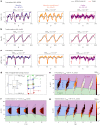Task-adaptive physical reservoir computing
- PMID: 37957266
- PMCID: PMC10769874
- DOI: 10.1038/s41563-023-01698-8
Task-adaptive physical reservoir computing
Abstract
Reservoir computing is a neuromorphic architecture that may offer viable solutions to the growing energy costs of machine learning. In software-based machine learning, computing performance can be readily reconfigured to suit different computational tasks by tuning hyperparameters. This critical functionality is missing in 'physical' reservoir computing schemes that exploit nonlinear and history-dependent responses of physical systems for data processing. Here we overcome this issue with a 'task-adaptive' approach to physical reservoir computing. By leveraging a thermodynamical phase space to reconfigure key reservoir properties, we optimize computational performance across a diverse task set. We use the spin-wave spectra of the chiral magnet Cu2OSeO3 that hosts skyrmion, conical and helical magnetic phases, providing on-demand access to different computational reservoir responses. The task-adaptive approach is applicable to a wide variety of physical systems, which we show in other chiral magnets via above (and near) room-temperature demonstrations in Co8.5Zn8.5Mn3 (and FeGe).
© 2023. The Author(s).
Conflict of interest statement
The authors declare no competing interests.
Figures





References
-
- Marković D, Mizrahi A, Querlioz D, Grollier J. Physics for neuromorphic computing. Nat. Rev. Phys. 2020;2:499–510.
-
- Schuman CD, et al. Opportunities for neuromorphic computing algorithms and applications. Nat. Comput. Sci. 2022;2:10–19. - PubMed
-
- Jaeger, H. The “Echo State” Approach to Analysing and Training Recurrent Neural Networks – With an Erratum Note (GMD-Forschungszentrum Informationstechnik, 2010).
-
- Maass W, Natschläger T, Markram H. Real-time computing without stable states: a new framework for neural computation based on perturbations. Neural Comput. 2002;14:2531–2560. - PubMed
-
- Nakajima, K. & Fischer, I. (eds) Reservoir Computing: Theory, Physical Implementations, and Applications (Springer, 2021).
Grants and funding
- RPG-2016-391/Leverhulme Trust
- RPG-2017-257/Leverhulme Trust
- EP/X015661/1/RCUK | Engineering and Physical Sciences Research Council (EPSRC)
- UCL Doctoral Prize/RCUK | Engineering and Physical Sciences Research Council (EPSRC)
- EP/S023259/1/RCUK | Engineering and Physical Sciences Research Council (EPSRC)
- TRR80, Project No. 107745057, Project G9/Deutsche Forschungsgemeinschaft (German Research Foundation)
- Katsu Research Encouragement Award and UTEC-UTokyo FSI Research Grant Program/University of Tokyo (Utokyo)
- PRESTO (JPMJPR18L5) and CREST (JPMJCR1874)/MEXT | JST | Accelerated Innovation Research Initiative Turning Top Science and Ideas into High-Impact Values (ACCEL)
LinkOut - more resources
Full Text Sources

